Description of a character in a literary work. Comparative characteristics of heroes How to write an essay
Comparative characteristics- one of the most popular types today school essays. In fact, this is an essay-reasoning based on a comparison of two characters from the same or different works.
Many heroes in Russian literature are given in "pairs":
Onegin - Lensky,
Onegin - Tatyana,
Onegin - author,
Pechorin - Grushnitsky,
Bazarov - Arkady Kirsanov,
Bazarov - Pavel Petrovich Kirsanov,
Pierre - Andrey,
Kutuzov - Napoleon, etc.
A comparative characteristic often helps us to see in a new way, it would seem, famous heroes. In the introduction to such an essay, we define the problem on which we will work, because it is not the comparison itself that is important to us. Comparison of characters is only a way of a deeper understanding of the work, of comprehending the author's intention, a way of solving some acute problem. worthwhile question etc. Such an essay cannot be "problem-free".
The wording of the topics can be quite traditional ("Oblomov and Stolz in I.A. Goncharov's novel "Oblomov"), or they may contain some new turn("Bazarov and Nikolai Kirsanov. The meaning of images in I.S. Turgenev's novel "Fathers and Sons"). In any case, the main word in the formulation that determines the composition of such a work is the union "and".
In no case should a comparative description be turned into a retelling - to talk first about one, then about another hero. Comparison must necessarily take place in parallel, and two heroes must be compared on the same grounds or in similar (similar) situations. "Figuratively speaking, if you said that one character's head looks like a radish with its tail up, then immediately outline the shape of the head of another, and without fail with a mention of the radish and its tail," the author of the excellent article "Compare wisely!" BEHIND. Blumin. ("Literature". Supplement to the magazine "First of September" No. 10, 2000, p. 8).
By dividing the comparison into a series of smaller comparisons, we can follow the text, analyzing the episodes and comparing our heroes (while not losing sight of the problem posed!). Let's compare:
- hero's first appearance
- portrait
- living environment
- relationship with people close to him, with society
- behavior in similar situations
- author's attitude to the hero, etc.
By the way, here is the outline of your essay.
Analysis of the text, strokes to the portrait, "talking" details, speech - these will be our arguments. Pay special attention to those artistic means with which the author portrays his hero. It can be comparisons, epithets, vocabulary features relating to the hero, the details that create the mood. Nothing happens by chance in a work of art. For example, why does Svidrigailov appear in Raskolnikov's closet after the third dream, a nightmare dream, literally merging with him, as if growing out of this dream? vision, it would seem, well known. Comparing different, opposite in character qualities of characters, we sometimes find their similarities, and vice versa: in outwardly similar characters there is a deep difference.
So, reflecting on the images of such an energetic, active Stolz and watching him at the end of the novel, when he is happy in his isolated, limited, cozy little world - in a house on the seashore, "entwined with grapes", you involuntarily think: how similar it is to "ennobled" Oblomovka, where life flows correctly and evenly and where the anxieties of the surrounding world do not reach!
Now tell me, are Oblomov and his servant Zakhar similar? Yes, and it would seem strange to compare! But think about it: after all, the author himself tells us that Zakhar is still in more Oblomov than Ilya Ilyich himself ... When building a composition of comparative characteristics, remember that at the beginning of a work it is always better to dwell on the similarity of the characters, because the main thing is their difference. But the "reverse" composition is also possible: from external differences to a deep inner similarity. Correctly (i.e., interesting, effective) to build an essay will always help you that particular "couple" with which you work.
When comparing, pay attention to whether this is the main character (characters) or a secondary one, to the place that the characters occupy in the composition of the work.
It is very important to note the dynamics of the image, that is, how the hero changes (and changes) throughout the entire work of art. Sometimes the hero is given statically by the author. For example, they change internally, being in a constant search for truth, positive heroes of Tolstoy, and its negative characters are absolutely static (why?). It would seem that such an uninteresting - against the background of the bright Pechorin - Grushnitsky in the story "Princess Mary" goes through his tragic way from an ordinary young man to a scoundrel, and all along this way he wants to be unusual, he wants to be a man of strong passions. But re-read the final scene: "I despise myself, but I hate you! There is no place for the two of us on earth! .." By the intensity of feelings (and the reader's sympathy), the characters seemed to change places at that moment, but how dearly Grushnitsky paid for this .. .
When completing your essay, do not forget the main thing: tell us about the result, conclusion that such a study of the characters' characters as a comparative characteristic led you to.
Reminder of the comparative characteristics of literary characters Reminder "How to compare" 1. Answer the questions: "Who is this?", "What is this?". 2. Compare the definitions of two objects or phenomena. 3. Highlight the essential features of each item. 4....
Reminder of the comparative characteristics of literary characters Reminder "How to compare" 1. Answer the questions: "Who is this?", "What is this?". 2. Compare the definitions of two objects or phenomena. 3. Highlight the essential features of each item. 4. Compare both or several compared objects according to the same selected features. 5. Find out all the signs of similarities and differences between objects. 6. Find and explain the reasons for their similarities and differences. Comparative characteristics components: 1. general characteristics literary work. 2. System of images. The place of the opposing characters in a number of other characters of the work. 3. Revealing what brings the characters together provides a basis for their comparison (age, education, social status etc.) 4. Determination of criteria that can become the basis for opposing heroes. 5. Contrasting characters based on the selected criteria (comparison of their actions, character traits that they show in similar
Reminder of the comparative characteristics of literary characters Reminder "How to compare" 1. Answer the questions: "Who is this?", "What is this?". 2. Compare the definitions of two objects or phenomena. 3. Highlight the essential features of each item. 4. Compare both or several compared objects according to the same selected features. 5. Find out all the signs of similarities and differences between objects. 6. Find and explain the reasons for their similarities and differences. Comparative characteristics components: 1. General characteristics of a literary work. 2. System of images. The place of the opposing characters in a number of other characters of the work. 3. Identification of what brings the characters together, provides a basis for their comparison (age, education, social status, etc.) 4. Determination of criteria that can become the basis for opposing the characters. 5. Contrasting characters based on the selected criteria (comparison of their actions, character traits that they show in similar situations). 6. Identification of the role of opposing literary characters in the implementation of the author's intention. When characterizing the hero of a literary work, the plan will help you: Determining the place of the hero among other characters. The degree of participation and its role in the conflict (episode). Presence of prototypes and autobiographical traits. Name analysis. Portrait. Appearance, as it is given by the author and in the perception of other characters.
Speech characteristic. Description of household items, housing, clothing, living conditions, as a means of self-expression of the hero. Family, upbringing, life history. Occupation. Traits. The evolution of personality in the process of plot development. Actions and motives of behavior in which the hero manifests himself most clearly. Direct author's characteristic. Attitude towards the hero of other characters of the work. Comparison with other characters or literary hero of another author. Evaluation of a literary character by his contemporaries. The hero as a product of his era and an exponent of a certain worldview. Definition of typical and individual in literary hero. Your personal attitude towards the character and this type of people in life. 1. It is necessary to conduct a parallel characterization, a parallel analysis, and at first it is advisable to consider common features characteristic of the characters, and then the opposite in them. 2. It is always necessary to compare according to essential, and not according to secondary signs, and also according to the same signs (origin, worldview, moral qualities of one - the moral qualities of another hero). 3. In some cases, in the comparative description, the main place is given to similarities (Wild and Kabanikha), in others, the emphasis is on differences (Katerina and Varvara). And accordingly, methods of comparison and opposition are used to one degree or another.
Comparison and opposition There are 2 types of comparison: by similarity and by contrast (contrast). Common Mistake writing an essay- comparative characteristic: simplified analysis of images. First characterize one character, and then another. It turns out two small essays about two heroes. But it is necessary to conduct a parallel characterization, a parallel analysis, and at first it is advisable to consider the common features inherent in the characters, and then the opposite in them.
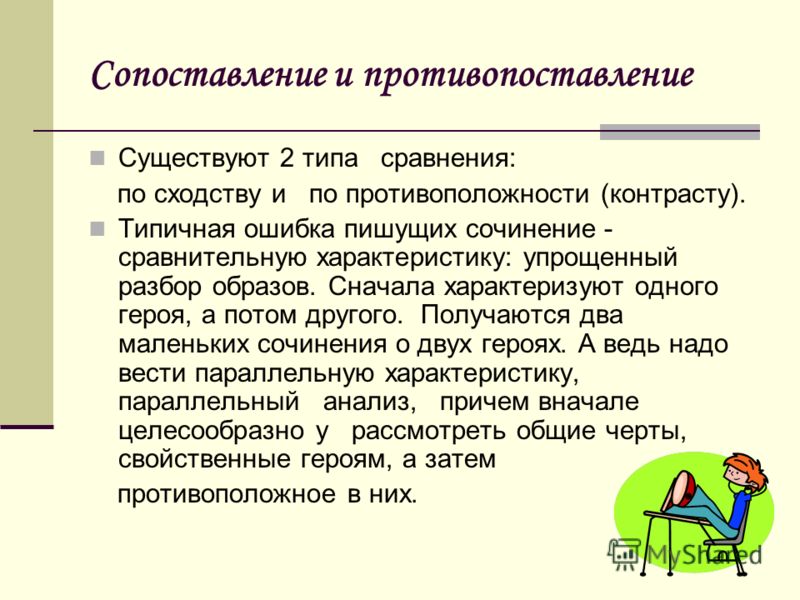
It is always necessary to compare according to essential, and not secondary, signs, and also according to the same signs (the origin of one is the origin of the other, the worldview of one is the worldview of the other, the moral qualities of one are the moral qualities of another hero). Finally, you need to identify similarities and differences at the same time. A one-sided comparison is fraught with danger: if we consider only similarities or only differences, we can come to an incomplete, distorted understanding of objects, phenomena, events, heroes. It should be borne in mind that in some cases, in the comparative description, the main place is given to similarities (Wild and Kabanikha), in others, the emphasis is on differences (Katerina and Varvara). And accordingly, methods of comparison and opposition are used to one degree or another.
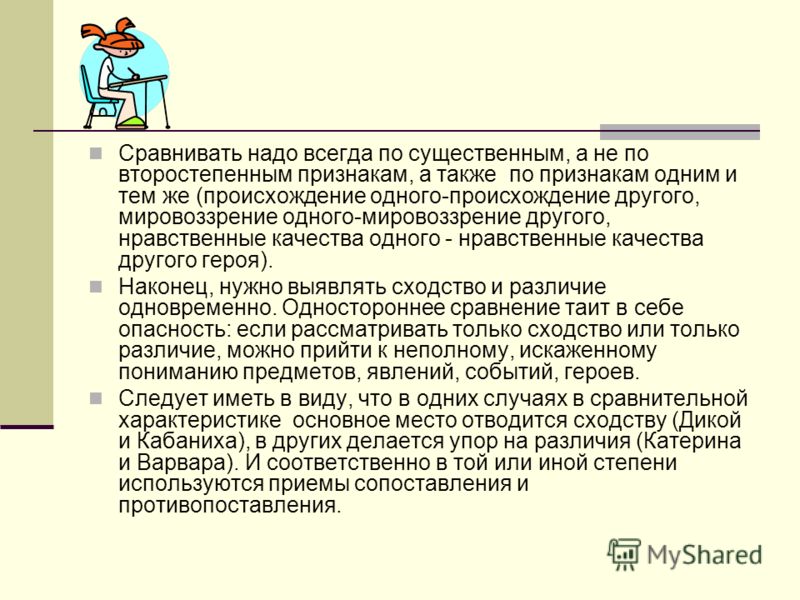
A comparative characteristic enhances the emotional impression, allows you to penetrate deeper into the essence of the compared (opposed) characters, comprehend their role in revealing the entire system of images of the work, its ideological and artistic originality, and more fully identify the author's characters, to the depicted.
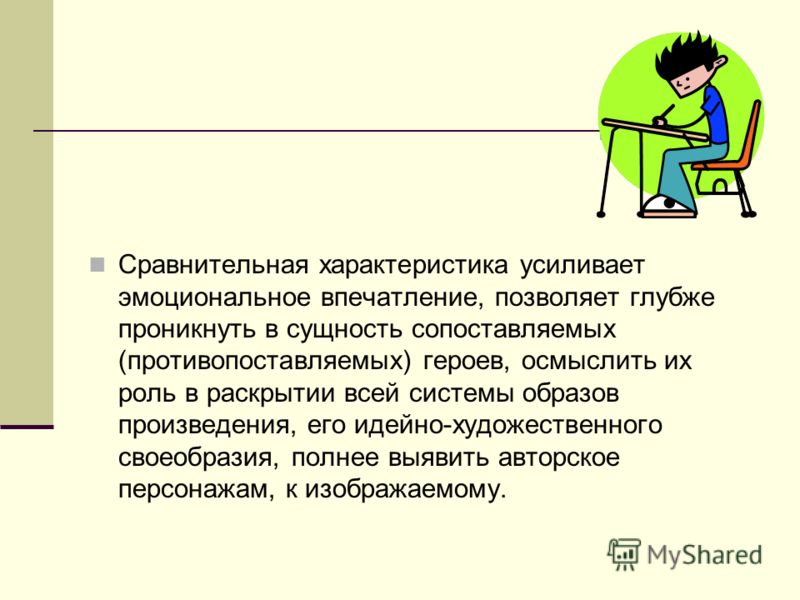
The essay is a comparative characteristic. Onegin and Tatyana. Plan. 1. Introduction. What is the meaning of life - the main question of the novel by A.S. Pushkin "Eugene Onegin". II. Main part. Onegin and Tatyana. 1. Similar features: 1) relatively broad knowledge; 2) insight of the mind; 3) independence; 4) honesty, truthfulness in the relationship between Onegin and Tatyana; 5) loneliness in the environment to which they belonged by birth. 2. Contrasting qualities: 1) Eugene's selfishness and Tatyana's spiritual generosity; a) in love b) in other human relationships; 2) Onegin's indifference and Tatyana's deep attachment to the "low" nature and people. III. Conclusion. 1. The denial of egoism and the affirmation of folk principles in human life are the essence of the images of Eugene Onegin and Tatyana Larina. 2. Under what condition can life be filled with high content? So, an analysis of the similarities and contrasts between the characters makes it possible to see in them what is common, important in the historical, social or morally and at the same time the individual uniqueness of each.
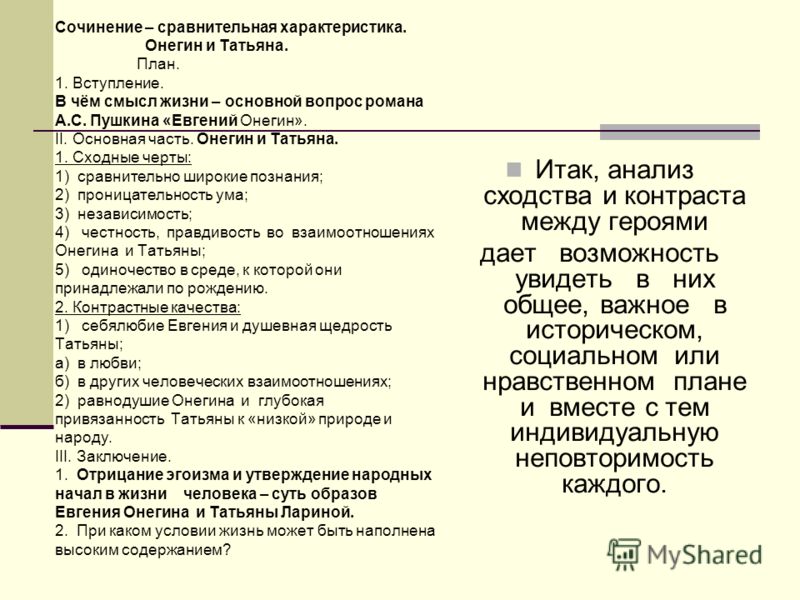
Themes of essays by type of comparative characteristics For this type of essay, options are possible, for example: “ life positions Chatsky and Molchalin"; “Onegin and Tatiana in the assessment of V.G. Belinsky"; "Onegin and Pechorin as exponents of their eras"; "Honor in the understanding of Pechorin and Grushnitsky"; "The tragedy of a pure soul: a comparative description of Larisa ("Dowry") and Katerina ("Thunderstorm")"; "Oblomov and Stolz"; "Disputes of Pavel Kirsanov and Evgeny Bazarov"; "The Truth of Raskolnikov and the Truth of Sonya"; "The spiritual quest of Andrei Bolkonsky and Pierre Bezukhov"; “I have been waiting for you for a long time” (Natasha Rostova and Andrei Bolkonsky)”; "The meaning of the opposition of Kutuzov and Napoleon"; "Tikhon Shcherbaty and Platon Karataev as Russian national types"; "Attitude to the Cherry Orchard by Ranevskaya and Lopakhin"; “The humanism of Luke and the humanism of Satin (based on the play by M. Gorky "At the bottom""); “Opposition of Woland and Yeshua in M. A. Bulgakov’s novel “The Master and Margarita””; " Moral Choice Sotnikov and Rybak in the story of V. V. Bykov.
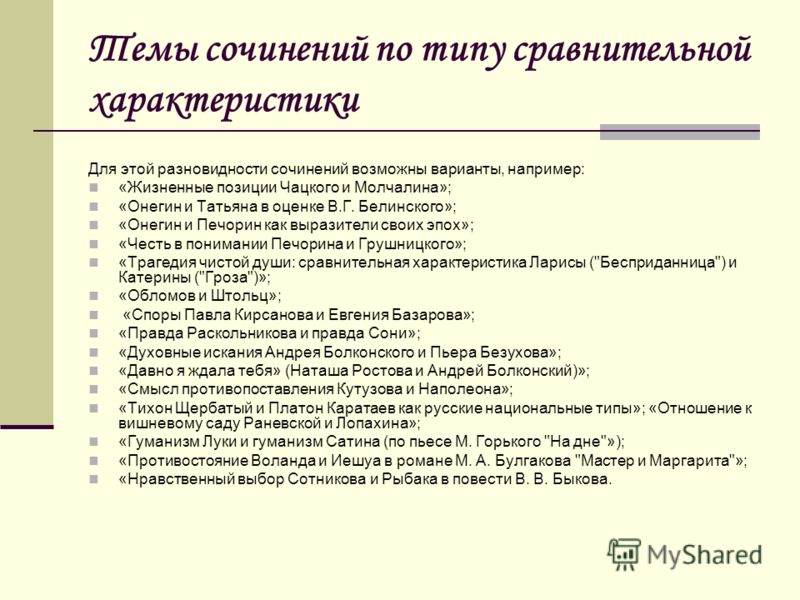
How to write an introduction and conclusion? Mtsyri and the Demon SAMPLE INTRODUCTION: In the work of M.Yu. Lermontov, two types of protesting heroes can be traced. Those who, in the fight against evil, adhere to the nationwide ethical norm (Mtsyri belongs to such), and individualists of a rebellious warehouse, violators of nationwide morality (The Demon belongs to them). Chatsky and Onegin SAMPLE CONCLUSION: I.A. Goncharov in his article "A Million of Torments" speaks of the typicality of Chatsky and Onegin. These types will invariably emerge in a critical era. Onegins are “superfluous” people in their environment, their appearance always indicates trouble, an impending collapse social structure. These people are head and shoulders above their contemporaries, they are distinguished by clairvoyance and a sharp, chilled mind. The Chatskys continue, develop what they started superfluous people. They not only silently condemn, despise, but also openly hate, denounce, ridicule. Chatsky - "A sincere and ardent figure ..." He begins new Age- and this is all its meaning and all the mind, ”says Goncharov.
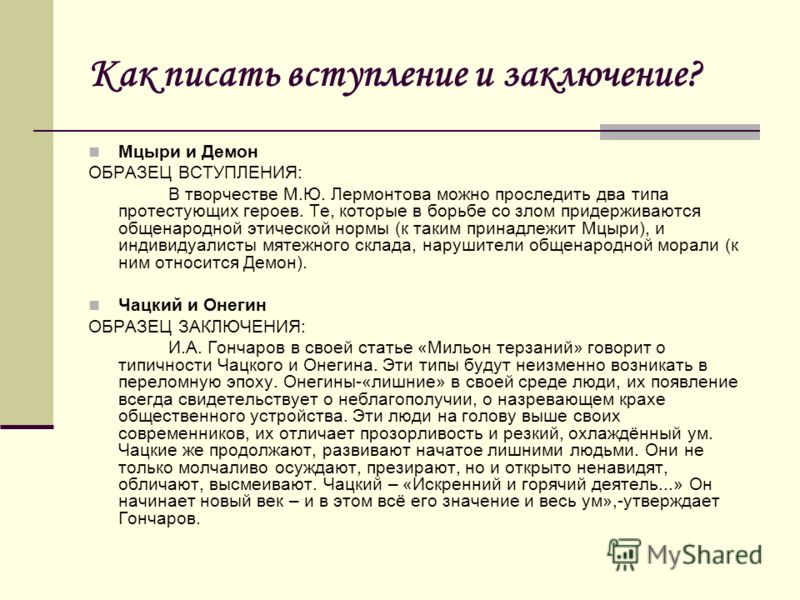
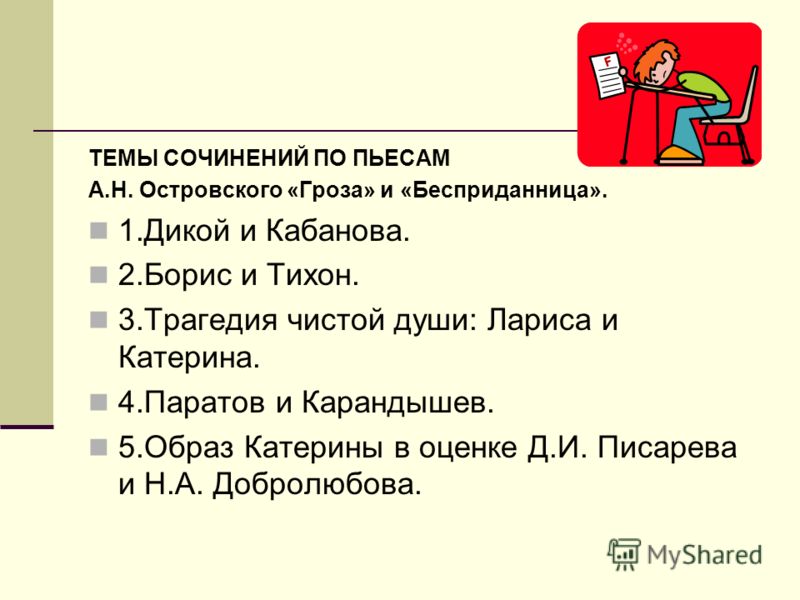
Larisa and Katerina - comparative characteristics. PLAN I. Plays by A.N. Ostrovsky "Thunderstorm" and "Dowry" about the position of women in Russia. II. Life and fate of the main characters. Features of difference: 1) Social position. 2) Lifestyle. Similarities: Character traits. 1) Unhappy love. 2) The role of the surrounding heroines in the tragedy. 3) Tragic fate: who is to blame? III. Could there have been another way out of the circumstances at that time? Why?
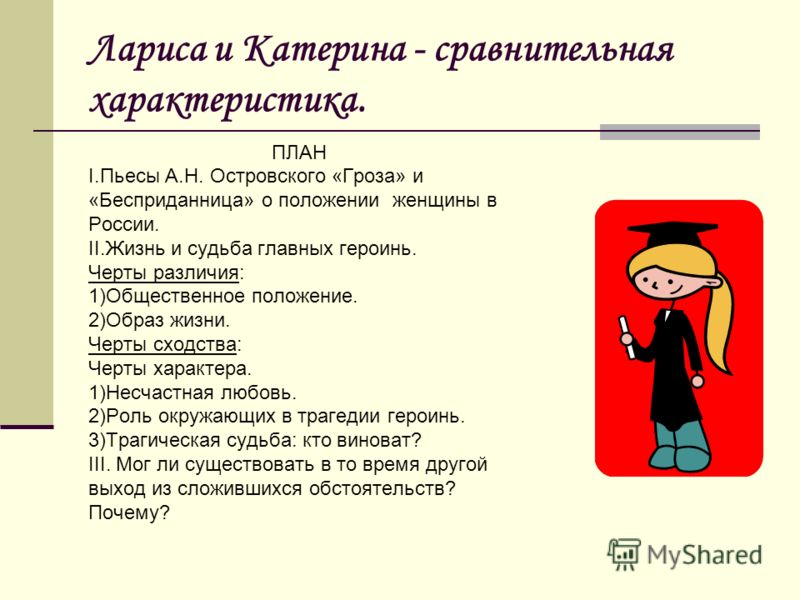
 Two heads and six legs; four walk, and two lie still
Two heads and six legs; four walk, and two lie still Self-esteem - what is it: concept, structure, types and levels
Self-esteem - what is it: concept, structure, types and levels Cassandra's Path, or Pasta Adventures War on Earth and Underground
Cassandra's Path, or Pasta Adventures War on Earth and Underground